#significance of software testing
Explore tagged Tumblr posts
Text
Conspiratorialism as a material phenomenon

I'll be in TUCSON, AZ from November 8-10: I'm the GUEST OF HONOR at the TUSCON SCIENCE FICTION CONVENTION.

I think it behooves us to be a little skeptical of stories about AI driving people to believe wrong things and commit ugly actions. Not that I like the AI slop that is filling up our social media, but when we look at the ways that AI is harming us, slop is pretty low on the list.
The real AI harms come from the actual things that AI companies sell AI to do. There's the AI gun-detector gadgets that the credulous Mayor Eric Adams put in NYC subways, which led to 2,749 invasive searches and turned up zero guns:
https://www.cbsnews.com/newyork/news/nycs-subway-weapons-detector-pilot-program-ends/
Any time AI is used to predict crime – predictive policing, bail determinations, Child Protective Services red flags – they magnify the biases already present in these systems, and, even worse, they give this bias the veneer of scientific neutrality. This process is called "empiricism-washing," and you know you're experiencing it when you hear some variation on "it's just math, math can't be racist":
https://pluralistic.net/2020/06/23/cryptocidal-maniacs/#phrenology
When AI is used to replace customer service representatives, it systematically defrauds customers, while providing an "accountability sink" that allows the company to disclaim responsibility for the thefts:
https://pluralistic.net/2024/04/23/maximal-plausibility/#reverse-centaurs
When AI is used to perform high-velocity "decision support" that is supposed to inform a "human in the loop," it quickly overwhelms its human overseer, who takes on the role of "moral crumple zone," pressing the "OK" button as fast as they can. This is bad enough when the sacrificial victim is a human overseeing, say, proctoring software that accuses remote students of cheating on their tests:
https://pluralistic.net/2022/02/16/unauthorized-paper/#cheating-anticheat
But it's potentially lethal when the AI is a transcription engine that doctors have to use to feed notes to a data-hungry electronic health record system that is optimized to commit health insurance fraud by seeking out pretenses to "upcode" a patient's treatment. Those AIs are prone to inventing things the doctor never said, inserting them into the record that the doctor is supposed to review, but remember, the only reason the AI is there at all is that the doctor is being asked to do so much paperwork that they don't have time to treat their patients:
https://apnews.com/article/ai-artificial-intelligence-health-business-90020cdf5fa16c79ca2e5b6c4c9bbb14
My point is that "worrying about AI" is a zero-sum game. When we train our fire on the stuff that isn't important to the AI stock swindlers' business-plans (like creating AI slop), we should remember that the AI companies could halt all of that activity and not lose a dime in revenue. By contrast, when we focus on AI applications that do the most direct harm – policing, health, security, customer service – we also focus on the AI applications that make the most money and drive the most investment.
AI hasn't attracted hundreds of billions in investment capital because investors love AI slop. All the money pouring into the system – from investors, from customers, from easily gulled big-city mayors – is chasing things that AI is objectively very bad at and those things also cause much more harm than AI slop. If you want to be a good AI critic, you should devote the majority of your focus to these applications. Sure, they're not as visually arresting, but discrediting them is financially arresting, and that's what really matters.
All that said: AI slop is real, there is a lot of it, and just because it doesn't warrant priority over the stuff AI companies actually sell, it still has cultural significance and is worth considering.
AI slop has turned Facebook into an anaerobic lagoon of botshit, just the laziest, grossest engagement bait, much of it the product of rise-and-grind spammers who avidly consume get rich quick "courses" and then churn out a torrent of "shrimp Jesus" and fake chainsaw sculptures:
https://www.404media.co/email/1cdf7620-2e2f-4450-9cd9-e041f4f0c27f/
For poor engagement farmers in the global south chasing the fractional pennies that Facebook shells out for successful clickbait, the actual content of the slop is beside the point. These spammers aren't necessarily tuned into the psyche of the wealthy-world Facebook users who represent Meta's top monetization subjects. They're just trying everything and doubling down on anything that moves the needle, A/B splitting their way into weird, hyper-optimized, grotesque crap:
https://www.404media.co/facebook-is-being-overrun-with-stolen-ai-generated-images-that-people-think-are-real/
In other words, Facebook's AI spammers are laying out a banquet of arbitrary possibilities, like the letters on a Ouija board, and the Facebook users' clicks and engagement are a collective ideomotor response, moving the algorithm's planchette to the options that tug hardest at our collective delights (or, more often, disgusts).
So, rather than thinking of AI spammers as creating the ideological and aesthetic trends that drive millions of confused Facebook users into condemning, praising, and arguing about surreal botshit, it's more true to say that spammers are discovering these trends within their subjects' collective yearnings and terrors, and then refining them by exploring endlessly ramified variations in search of unsuspected niches.
(If you know anything about AI, this may remind you of something: a Generative Adversarial Network, in which one bot creates variations on a theme, and another bot ranks how closely the variations approach some ideal. In this case, the spammers are the generators and the Facebook users they evince reactions from are the discriminators)
https://en.wikipedia.org/wiki/Generative_adversarial_network
I got to thinking about this today while reading User Mag, Taylor Lorenz's superb newsletter, and her reporting on a new AI slop trend, "My neighbor’s ridiculous reason for egging my car":
https://www.usermag.co/p/my-neighbors-ridiculous-reason-for
The "egging my car" slop consists of endless variations on a story in which the poster (generally a figure of sympathy, canonically a single mother of newborn twins) complains that her awful neighbor threw dozens of eggs at her car to punish her for parking in a way that blocked his elaborate Hallowe'en display. The text is accompanied by an AI-generated image showing a modest family car that has been absolutely plastered with broken eggs, dozens upon dozens of them.
According to Lorenz, variations on this slop are topping very large Facebook discussion forums totalling millions of users, like "Movie Character…,USA Story, Volleyball Women, Top Trends, Love Style, and God Bless." These posts link to SEO sites laden with programmatic advertising.
The funnel goes:
i. Create outrage and hence broad reach;
ii, A small percentage of those who see the post will click through to the SEO site;
iii. A small fraction of those users will click a low-quality ad;
iv. The ad will pay homeopathic sub-pennies to the spammer.
The revenue per user on this kind of scam is next to nothing, so it only works if it can get very broad reach, which is why the spam is so designed for engagement maximization. The more discussion a post generates, the more users Facebook recommends it to.
These are very effective engagement bait. Almost all AI slop gets some free engagement in the form of arguments between users who don't know they're commenting an AI scam and people hectoring them for falling for the scam. This is like the free square in the middle of a bingo card.
Beyond that, there's multivalent outrage: some users are furious about food wastage; others about the poor, victimized "mother" (some users are furious about both). Not only do users get to voice their fury at both of these imaginary sins, they can also argue with one another about whether, say, food wastage even matters when compared to the petty-minded aggression of the "perpetrator." These discussions also offer lots of opportunity for violent fantasies about the bad guy getting a comeuppance, offers to travel to the imaginary AI-generated suburb to dole out a beating, etc. All in all, the spammers behind this tedious fiction have really figured out how to rope in all kinds of users' attention.
Of course, the spammers don't get much from this. There isn't such a thing as an "attention economy." You can't use attention as a unit of account, a medium of exchange or a store of value. Attention – like everything else that you can't build an economy upon, such as cryptocurrency – must be converted to money before it has economic significance. Hence that tooth-achingly trite high-tech neologism, "monetization."
The monetization of attention is very poor, but AI is heavily subsidized or even free (for now), so the largest venture capital and private equity funds in the world are spending billions in public pension money and rich peoples' savings into CO2 plumes, GPUs, and botshit so that a bunch of hustle-culture weirdos in the Pacific Rim can make a few dollars by tricking people into clicking through engagement bait slop – twice.
The slop isn't the point of this, but the slop does have the useful function of making the collective ideomotor response visible and thus providing a peek into our hopes and fears. What does the "egging my car" slop say about the things that we're thinking about?
Lorenz cites Jamie Cohen, a media scholar at CUNY Queens, who points out that subtext of this slop is "fear and distrust in people about their neighbors." Cohen predicts that "the next trend, is going to be stranger and more violent.”
This feels right to me. The corollary of mistrusting your neighbors, of course, is trusting only yourself and your family. Or, as Margaret Thatcher liked to say, "There is no such thing as society. There are individual men and women and there are families."
We are living in the tail end of a 40 year experiment in structuring our world as though "there is no such thing as society." We've gutted our welfare net, shut down or privatized public services, all but abolished solidaristic institutions like unions.
This isn't mere aesthetics: an atomized society is far more hospitable to extreme wealth inequality than one in which we are all in it together. When your power comes from being a "wise consumer" who "votes with your wallet," then all you can do about the climate emergency is buy a different kind of car – you can't build the public transit system that will make cars obsolete.
When you "vote with your wallet" all you can do about animal cruelty and habitat loss is eat less meat. When you "vote with your wallet" all you can do about high drug prices is "shop around for a bargain." When you vote with your wallet, all you can do when your bank forecloses on your home is "choose your next lender more carefully."
Most importantly, when you vote with your wallet, you cast a ballot in an election that the people with the thickest wallets always win. No wonder those people have spent so long teaching us that we can't trust our neighbors, that there is no such thing as society, that we can't have nice things. That there is no alternative.
The commercial surveillance industry really wants you to believe that they're good at convincing people of things, because that's a good way to sell advertising. But claims of mind-control are pretty goddamned improbable – everyone who ever claimed to have managed the trick was lying, from Rasputin to MK-ULTRA:
https://pluralistic.net/HowToDestroySurveillanceCapitalism
Rather than seeing these platforms as convincing people of things, we should understand them as discovering and reinforcing the ideology that people have been driven to by material conditions. Platforms like Facebook show us to one another, let us form groups that can imperfectly fill in for the solidarity we're desperate for after 40 years of "no such thing as society."
The most interesting thing about "egging my car" slop is that it reveals that so many of us are convinced of two contradictory things: first, that everyone else is a monster who will turn on you for the pettiest of reasons; and second, that we're all the kind of people who would stick up for the victims of those monsters.

Tor Books as just published two new, free LITTLE BROTHER stories: VIGILANT, about creepy surveillance in distance education; and SPILL, about oil pipelines and indigenous landback.


If you'd like an essay-formatted version of this post to read or share, here's a link to it on pluralistic.net, my surveillance-free, ad-free, tracker-free blog:
https://pluralistic.net/2024/10/29/hobbesian-slop/#cui-bono

Image: Cryteria (modified) https://commons.wikimedia.org/wiki/File:HAL9000.svg
CC BY 3.0 https://creativecommons.org/licenses/by/3.0/deed.en
#pluralistic#taylor lorenz#conspiratorialism#conspiracy fantasy#mind control#a paradise built in hell#solnit#ai slop#ai#disinformation#materialism#doppelganger#naomi klein
306 notes
·
View notes
Text

The Artisul team was kind enough to send me their Artisul D16 display tablet to review! Timelapse and review can be found under the read more.
I have been using the same model of display tablet for over 10 years now (a Wacom Cintiq 22HD) and feel like I might be set in my ways, so getting the chance to try a different brand of display tablet was also a new experience for me!
The Unboxing
The tablet arrived in high-quality packaging with enough protection that none of the components get scratched or banged up in the shipping process. I was pleasantly surprised that additionally to the tablet, pen, stand, cables and nibs it also included a smudge guard glove and a pen case.
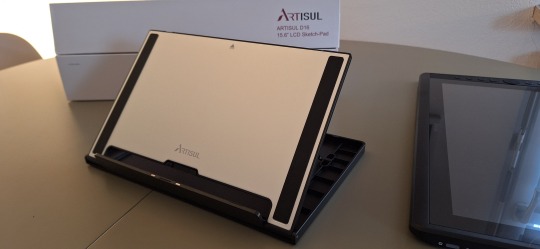
The stand is very light-weight and I was at first worried that it would not be able to hold up the tablet safely, but it held up really well. I appreciated that it offered steeper levels of inclination for the tablet, since I have seen plenty other display tablets who don’t offer that level of ergonomics for artists. My only gripe is that you can’t anchor the tablet to the stand. It will rest on the stand and can be easily taken on or off, but that also means that you can bump into it and dislodge it from the stand if you aren’t careful. It would require significant force, but as a cat owner, I know that a scenario like that is more likely than I’d like.
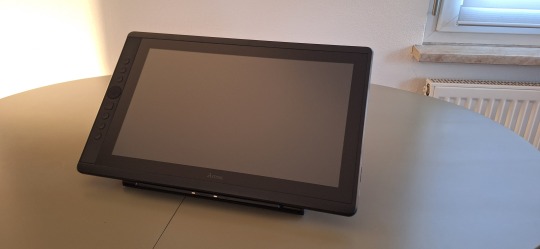
Another thing I noticed is how light the tablet is in comparison to my Cintiq. Granted, my Cintiq is larger (22 inches vs the 15.8 inches of the Artisul D16), but the Artisul D16 comes in at about 1.5kg of weight. While I don’t consider display tablets that require a PC and an outlet to work really portable, it would be a lot easier to move with the Artisul D16 from one space to another. In comparison, my Cintiq weighs in at a proud 8.5kg, making it a chore to move around. I have it hooked up to a monitor stand to be able to move it more easily across my desk.
The Setup
The setup of the tablet was quick as well, with only minor hiccups. The drivers installed quickly and basic setup was done in a matter of minutes. That doesn’t mean it came without issues: the cursor vanished as soon as I hovered over the driver window, making it a guessing game where I would be clicking and the pen calibration refused to work on the tablet screen and instead always defaulted to my regular screen. I ended up using the out of the box pen calibration for my test drawing which worked well enough.
The tablet comes with customizable hot-keys that you can reassign in the driver software. I did not end up using the hot-keys, since I use a Razer Tartarus for all my shortcuts, but I did play around with them to get a feel for them. The zoom wheel had a very satisfying haptic feel to it which I really enjoyed, and as far as I could tell, you can map a lot of shortcuts to the buttons, including with modifier keys like ctrl, shift, alt and the win key. I noticed that there was no option to map numpad keys to these buttons, but I was informed by my stream viewers that very few people have a full size keyboard with a numpad anymore.
The pen comes with two buttons as well. Unlike the hot-keys on the side of the tablet, these are barely customizable. I was only able to assign mouse clicks to them (right, left, scroll wheel click, etc) and no other hotkeys. I have the alt key mapped to my pen button on my Cintiq, enabling me to color pick with a single click of the pen. The other button is mapped to the tablet menu for easy display switches. Not having this level of customization was a bit of a bummer, but I just ended up mapping the alt key to a new button on my Razer Tartarus and moved on.
The pen had a very similar size to my Wacom pen, but was significantly lighter. It also rattled slightly when shook, but after inspection this was just the buttons clicking against the outer case and no internal issues. The pen is made from one material, a smooth plastic finish. I would have liked for there to be a rubber-like material at the grip like on the Wacom pen for better handling, but it still worked fine without it.
Despite not being able to calibrate the pen for the display tablet, the cursor offset was minimal. It took me a while at the beginning to get used to the slight difference to my current tablet, but it was easy to get used to it and I was able to smoothly ink and color with the tablet. The screen surface was very smooth, reminding me more of an iPad surface. The included smudge guard glove helped mitigate any slipping or sliding this might have caused, enabling me to draw smoothly. Like with the cursor offset, it took me a while to get used to the different pressure sensitivity of the tablet, but I adapted quickly.
So what do I think of it?
Overall, drawing felt different on this tablet, but I can easily see myself getting used to the quirks of the tablet with time. Most of the issues I had were QoL things I am used to from my existing tablet.
But I think that’s where the most important argument for the tablet comes in: the price.
I love my Cintiq. I can do professional grade work on it and I rebought the same model after my old one got screen issues, I liked it that much. But it also costs more than a 1000 € still, even after being on the market for over 10 years (I bought it for about 1.500 € refurbished in 2014, for reference). The Artisul D16 on the other hand runs you a bit more than 200€. That is a significant price difference! I often get asked by aspiring artists what tools I use and while I am always honest with them, I also preface it by saying that they should not invest in a Cintiq if they are just starting out. They are high quality professional tools and have a price point that reflects that. You do not need these expensive tools to create art. You can get great results on a lot cheaper alternatives! I do this for a living so I can justify paying extra for the QoL upgrades the Cintiq offers me, but I have no illusion that they are an accessible tool for most people.
I can recommend the Artisul D16 as a beginner screen tablet for people who are just getting into art or want to try a display tablet for once. I wouldn’t give up my Cintiq for it, but I can appreciate the value it offers for the competitive price point. If you want to get an Artisul D16 for yourself, you can click this link to check out their shop!
AMAZON.US: https://www.amazon.com/dp/B07TQLGC81
AMAZON.JP: https://www.amazon.co.jp/dp/B07T6ZT84V
AMAZON.MX: https://www.amazon.com.mx/dp/B07T6ZT84V
Once again thank you to the Artisul team for giving me the opportunity to review their display tablet!
92 notes
·
View notes
Text


Everything about the Starship was the result of a series of decisions designed to make spaceflight cheaper. The methane fuel. The steel structure. The method of construction. Even the rocket’s enormous size. All of it was a gamble to create a system that is fully reusable, bringing the cost of getting to orbit down to a small fraction of what it is today and making space almost infinitely more accessible.
However, one decision in the process didn’t just result in the destruction of the rocket, it generated a cascade of failures, one that’s likely to set the program back by a least a year, erasing the chance of NASA’s scheduled return to the Moon in the process. That decision is 100% on Elon Musk.
HERE’S THE TL;DR VERSION
The no-clamps slow throttle-up meant Starship stayed on the pad for a long time, throwing up concrete, rock, and sand in all directions, damaging the pad, nearby facilities, and Starship itself.

By the time it left the pad, that debris had already destroyed three of Starship’s engines and likely damaged valves and systems that would lead to additional engine failures as well as an incorrect fuel mixture.
Starship was slow to reach every point in the flight plan, suggesting that other engines were not able to throttle up to compensate for the lost engines.
At what should have been stage separation, either software errors or more smashed hardware kept the main booster firing long after it should have shut down.
The result was an uncontrolled spin that required Starship to be destroyed.
WHY THIS IS 100% ELON MUSK’S FAULT
Starship is the work of hundreds of talented engineers and thousands of employees who put their best into making this thing go. The design is extremely daring, and something of a wonder. The engines are amazing, even if they have demonstrated that reliability is currently lacking. The whole system of construction promises to revolutionize the space industry.
But there are two parts that were left out of Starship that absolutely doomed this flight and the decision not to include them falls right with the guy at the end of the first row at “Star Command.”
Those parts were not parts for the rocket. They were parts for the launch pad.
For some reason, Musk became convinced early on that he did not want the launch tower to have:
A flame-diverter or flame trench to redirect the blast from the booster’s engines
A water deluge system to dump a massive amount of water around the launch tower during liftoff
The launch facilities at Kennedy have both of these. Even the launch pads used for the much smaller Falcon 9 have both a flame trench and a water deluge. They help to protect not just the launch pad, and the surrounding area, they also help to reduce the noise. Which sounds trivial, but that noise is energy. That’s what broke up the concrete under the Starship Stage Zero, not the fire. That’s what sent car-sized chunks flying in all directions.
A flame diverter and a water deluge would have greatly reduced, or even eliminated, the damage to the area around the pad. They would have prevented the blow back of debris that damaged Starship before it even left the ground. It might have headed off the whole cascade of events that resulted in that button being pressed 4 minutes into the flight.
We don’t have to guess about whose decision it was not to implement these systems, because Musk already said he decided to skip these systems over the recommendations of his engineers. Musk even had a preview of what was going to happen, as past test flights of the upper stage also resulted in significant spalling of concrete structures and damage to at least one of the ships. He just made them try different kinds of concrete.
The parts for a water deluge were actually on site, ready to install, but Musk decided to forego that installation—likely so he could enjoy the pun of launching his super-joint on 4/20. Which was something Musk had joked about doing months ago.
Hopefully he enjoyed the joke, because the EPA and FAA are going to be thinking long and hard before they authorize another flight from Boca Chica. All those engineers, and all those workers, and all their good work, is held hostage to Musk’s whims.
Also a victim of Musk’s decision to leave these vital pieces off the table? The Artemis Program at NASA. Musk has already been awarded the contract to create the first lunar lander for the new program, but that lander is absolutely dependent on Starship. It’s a sure bet that Musk won’t have his part of the program ready on schedule. It’s going to be some time before we even so another test flight.
In the meantime, SpaceX can repair the damage, build a flame diverter, install that deluge system, clean up the software, and ditch the whole “pitch over” means of stage separation for something simpler—like using the second stage engines to push the stages apart with an unignited shot of methane.
See you in 2024, Starship.
Maybe.
👉🏿 https://m.dailykos.com/stories/2023/4/22/2165317/-A-Starship-Post-mortem-Why-the-giant-rocket-failed-and-why-it-s-Elon-Musk-s-fault
2K notes
·
View notes
Note
idk how much engagement you get but if you're interested in an extra income, I have a free credit repair software and I can make you a referral link so you get a referral fee for everyone that signs up with your link.
Attention, baby bitchlings! This is clearly spam, but we're using it as a teaching moment.
I would never say yes to something like this for 2 reasons:
Part of our revenue model is endorsing companies for a cut of referrals (the other part being our Patreon, which you should absolutely join). Companies reach out to partner with us BECAUSE we have a big audience and BECAUSE we've built up a significant amount of trust with our audience. Y'all know we don't endorse stuff we haven't personally tested and researched. There's no way in HELL your humble Bitches would signal boost a completely random, unnamed "free credit repair software."
Most credit repair services are a scam or a waste of money. They recommend tactics you can do on your own for free (I'll link our guides for this below) without sharing your sensitive personal data with an outside company. The fact that anon is recommending a "free" credit repair software tells me that once you're in the software, their business model is to upsell you on other shit you don't need. Along with life insurance, credit repair services are one business model we'll never partner with for endorsements.
Now, if someone asks YOU to signal boost a referral link, think long and hard about it. Is it legit? Is it a scam? Is it something you're ok putting your name on if it means other people could be taken advantage of?
Now, if your credit needs repairing, here's what we recommend:
How to Build Good Credit Without Going Into Debt
Credit Scoring Is a Racist, Classist System that Has Us All Trapped
How To Fix an Error on Your Credit Report Without Losing Your Damn Mind
How to Instantly Increase Your Credit Score… for FREE
{ MASTERPOST } Everything You Need to Know about Credit and Credit Cards
Did we just help you out? Say thanks on Patreon!
96 notes
·
View notes
Text
The MS-07B Gouf
In preparation for the invasion of Earth, Zeon forces modified a number of MS-06 Zaku-II F-types for use under the effects of the planet's gravity. The new "J-type" Zaku-IIs featured a number of internal hardware and software changes to enhance their viability on the ground.
The Zaku-II J-Type would be used as a testbed for new developments with the goal of creating a new mass-production mobile suit for use on the ground. And where the Zaku was intended for anti-ship and anti-aerospace combat, this new platform would be built to fight other mobile suits.
Zimmad and Zeonic would both begin working on this new project, directly competing with one another, but eventually coming up with very similar designs. Zeonic moved forward with the YMS-07A Prototype Gouf, and Zimmad presented the YMS-08A High Mobility Test Type.


While Zimmad's design failed to show a significant increase in performance from the Zaku-II J-Type, Zeonic's "Gouf" showed immense promise. The prototype would be picked up and would see a limited production run as the MS-07A Gouf.

The MS-07A was a pre-production model intended for data gathering. The final mass-production model would feature several additional weapon systems, such as an in-built 75mm machine gun in the left manipulator, and a retractable "Heat Rod" on the left forearm.


The Gouf was used to great effect by Zeon captain Ramba Ral, who went toe-to-toe with the Earth Federation's infamous RX-78-2 Gundam.

Among the Ace pilots who used the Gouf as their personal units, Viche Donahue, Silas Locke, and Norris Packard were among the most well-known. All three of these aces would become battlefield legends, with Packard's MS-07B-3 Gouf Custom becoming especially infamous. The machine's equipment proved so effective that it became a common alternate loadout for many Gouf pilots.



The MS-07 would be customized for a variety of roles and theaters, with many of these variants seeing further developments of their own.



Notable among these was the MS-07W Gouf Combined Test Type, which featured a miniaturized Dopp fighter serving as its cockpit. The development of the machine was heavily influenced by data gathered from the Federation's RX-series of mobile suits. Namely, their "Core Block" system.


The Gouf would also see another fork, being developed into the MS-07H Gouf Flight Type. While both prototypes made use of thermonuclear rocket engines, the final version used thermonuclear jet engines, allowing for greater efficiency in atmospheric flight.



The MS-07B saw further refinement into the MS-07C. While not much is known about its specifications, there are at least three known variants. A number of Goufs were acquired by Zimmad and used as testbeds for systems to be incorporated into the MS-09 Dom series of mobile suits. These Goufs were MS-07Cs.



And finally, in UC 120, nearly 50 years from the initial deployment of the original machine, Mars Zeon would develop and deploy the OMS-07RF RF Gouf. While externally resembling the MS-07B, the OMS-07-RF was a completely new machine which could also operate in space, unlike its predecessors.

The MS-07B Gouf was originally designed by Kunio Okawara for the 1979 Anime "Mobile Suit Gundam".
This article was a request! Requests are always welcome!
I am so terribly sorry for the delay in getting this post out! It's been a very hectic few months, but I'm hoping to get back in the flow of things!
20 notes
·
View notes
Text
Why is landing an Internship as a Computer Engineering/Computer Science Student so hard ?
Hey there, dear coders!
I apologize for my long absence—life caught me off guard with a lot of work and projects. Now that I finally have some time, I wanted to make a post to connect with you all. Thank you so much for 1,000 subscribers! I know maintaining a community requires consistent posting, and I feel like many of you might have forgotten about me. But I promise to make something big out of this. I've been thinking about starting a newsletter where you can receive weekly emails from me, discussing something I learned that week or anything that intrigued me and I felt like sharing.
Now, back to our question: Is it really hard to land an internship as a computer science student? The answer is yes, and as a computer engineering student myself, I can attest to this.
I've often wondered why it's so difficult. After some observations, I discovered that almost every computer science student's resume looks the same. The portfolios are nearly identical, lacking uniqueness. If you've studied at the same school as your friends, what would make a recruiter choose you over them?
This is where uniqueness and a sense of self come in. Your portfolio or website should reflect exactly who you are as a person and highlight your strengths.
The second crucial factor is dedication. I've had classmates who are extremely dedicated. They might not have any special skills, but they show immense interest in what they want to do. This drive is palpable, and recruiters can sense it too.
Sometimes, the resume isn't even the most important aspect. For big companies like Oracle, what you say and know during the interview and technical tests matters more. The resume is just the very first step.
So, what I've learned along the way can be summed up in two words: uniqueness and dedication.
Now how to Create the Perfect Resume to Land an Internship as a Student ?
1. Keep the design simple:
Avoid extra designs or too many colors. While uniqueness is important, recruiters generally do not favor overly designed resumes.
2. Structure your resume properly:
- The Resume Header
Contact Information:
Full name and title: List your first and last name. Use the title of the role you want instead of your current title.
Professional email address: Use a clean format like [email protected].
Phone number: Choose the number you check most frequently. Record a professional voicemail greeting if yours is too casual.
Address: List only your city and state. Let recruiters know if you're willing to relocate if applicable.
LinkedIn or other professional social media: Include your LinkedIn profile if it's active and relevant. List any portfolios or computer engineering-related sites.
- The Resume Summary
A paragraph where you describe yourself by answering these questions:
What is your professional style? (Use one or two descriptive words such as patient, critical thinker, consensus builder, excellent designer.)
What is your greatest engineering strength?
What will you add to this particular team?
What is your process for building and maintaining computer networks?
What are you proudest of in your career?
Example:
Motivated computer engineering student with a strong foundation in software development and solid analytical and problem-solving skills. Looking for an opportunity to enhance my skills in a challenging professional environment.
- The Employment History Section
Be specific about how you contributed to each position and the impact you made.
List the job title, organization name, dates of employment, and 3–6 bullet points showcasing your achievements.
Start each bullet point with a strong action verb like collaborated or designed.
Highlight significant achievements rather than just listing responsibilities.
If you have no experience, include a projects section. This will act as your experience. Highlight how you worked on each project and your passion for it.
- The Skills Section
Combine hard and soft skills. The skills section is often the first place recruiters look to ensure you have the key abilities they're seeking. Your entire resume should support the skills you list here.
- The Education and Certifications Section
List your education, including any relevant courses or special achievements during your degree. Also, mention any certifications you have, whether from freeCodeCamp, Google, Coursera, etc.
By following these tips, you can create a resume that stands out and showcases your unique strengths and dedication. Good luck with your internship search, and remember to stay true to yourself!
#codeblr#studyblr#code#progblr#programming#css#comp sci#html#python#web development#instagram#internship#javascript#java development company#web design#web developers#website design#webdev#website#tech#html css#learn to code
23 notes
·
View notes
Text

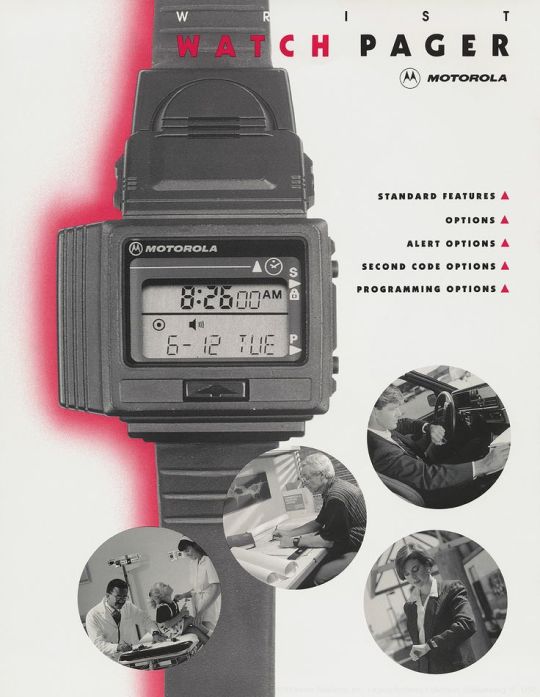

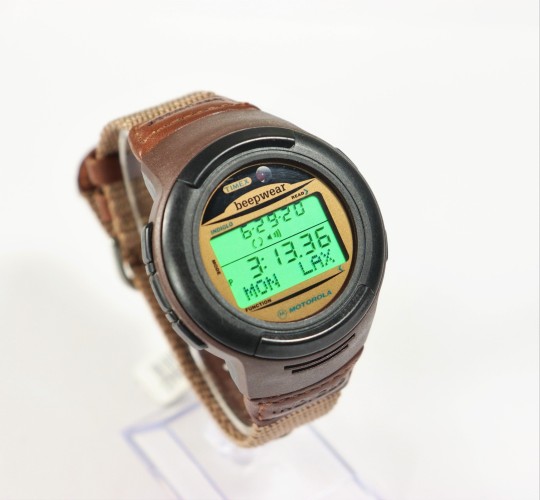
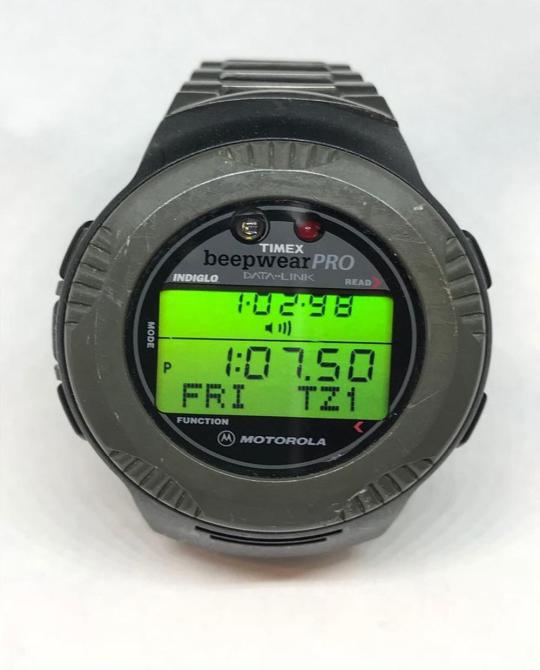
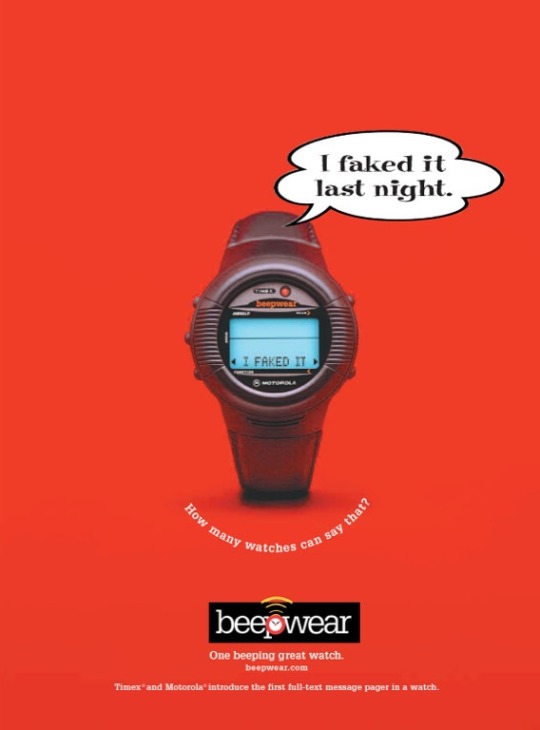
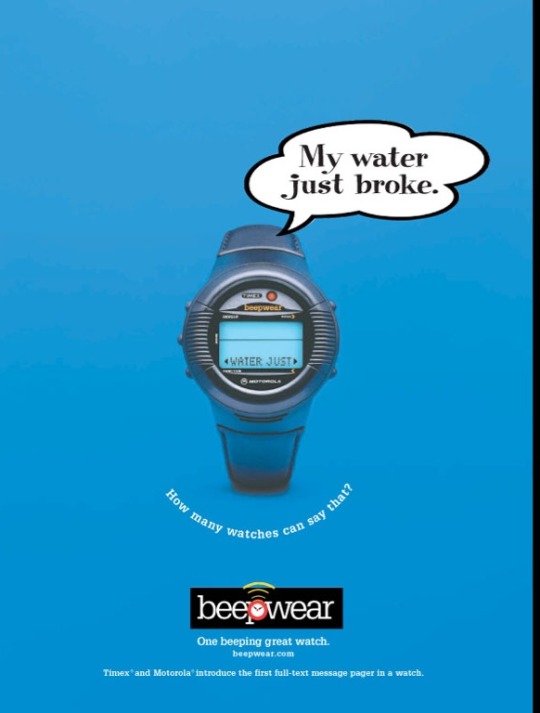
🇺🇲 Explore the Fascinating Fusion of Timekeeping and Communication: Unveiling the Pioneering Motorola and Timex Wristwatch-Pagers that Revolutionized Wearable Technology in the 1990s.
🤝 In 1990, Motorola Inc. made its first attempt to enter the market of electronic wristwatches with a built-in pager (similar devices at the same time were already produced by the Japanese companies Seiko and Casio). The device was called "Motorola Wrist Wach Pager". Since 1991, further production of the devices has been carried out jointly with the Timex Group Corporation under the name "The Timex Tracer Wrist Watch Pager".
👉 Since 1998, further development of the line of electronic watches with the participation of Motorola Inc. and Timex Group was associated with the high-tech "Timex Beepwear Datalink" series. These devices also continued the concept of wristwatch-pagers, but with the integration of the well-known Datalink data transmission platform, which integrates with desktop computer software.
➡️ The Datalink line was introduced in 1994 and was developed in conjunction with Microsoft Corporation as an alternative to conventional PDAs with added attributes such as water resistance and ease of programming. Taken together, all this made it possible to use the “Beepwear Datalink” watch as a full-fledged electronic organizer.
📟 The Beepwear Pager Watch epitomized the convergence of traditional wristwatches with cutting-edge communication capabilities. Introduced in the late 1990s, this innovative device redefined the concept of wearable tech, offering users unparalleled convenience and connectivity on the go.
📞 Equipped with pager functionality, the Beepwear Pager Watch allowed users to receive important notifications and messages directly on their wrist, eliminating the need for separate communication devices. With its sleek and compact design, it seamlessly integrated into everyday life, providing instant access to critical information wherever you went.
⌚️ Beyond its communication features, the Beepwear Pager Watch retained the timeless appeal of a classic timepiece, boasting a stylish and durable design that stood the test of time. With its reliable quartz movement and rugged construction, it was built to withstand the rigors of daily wear, ensuring longevity and reliability for its users.
⚙️ The "Beepware" series, as a joint product of the efforts of Timex Group and Motorola Inc. was patented, and the production of the devices was carried out by the newly created joint company "Beepwear Paging Products". The clock operated in the 900 MHz band. FLEX time was also used, which, if supported by the operator, could synchronize the clock time with the network time, and also automatically adjust to the owner's time zone.
🚀 The launch of the Timex Motorola Beepwear Pager Watch marked a significant milestone in the evolution of wearable technology, showcasing the potential for seamless integration of communication and timekeeping functions in a single device. As one of the pioneering products in this category, it paved the way for future innovations in the wearable tech industry, inspiring a new generation of smartwatches and wearable devices.
💔 However, already in 2002, Motorola Inc. was forced to carry out internal restructuring, including ceasing production and support of its own pagers.
💫 Today, the legacy of the Timex Motorola Beepwear Pager Watch lives on, remembered as a trailblazer in the realm of wearable technology. While newer devices may offer more advanced features, the Beepwear Pager Watch remains a symbol of innovation and ingenuity, reminding us of the transformative power of technology in shaping our lives.
#timetrek#brands#clock#watch#watches#time#companies#company#history#luxury watches#motorola#timex group#timex watches for men#timex#beepwear#pager#wristwatch#wrist watch#wristwatch pda#wristwatch pager#datalink#microsoft#smartwatch#digital watch#casio#seiko#made in usa#telecommunications#innovation#old gadgets
26 notes
·
View notes
Text
The Crew 9 delay is relevant to the Starliner dilemma for a couple of reasons. One, it gives NASA more time to determine the flight-worthiness of Starliner. However, there is also another surprising reason for the delay—the need to update Starliner’s flight software. Three separate, well-placed sources have confirmed to Ars that the current flight software on board Starliner cannot perform an automated undocking from the space station and entry into Earth’s atmosphere. At first blush, this seems absurd. After all, Boeing’s Orbital Flight Test 2 mission in May 2022 was a fully automated test of the Starliner vehicle. During this mission, the spacecraft flew up to the space station without crew on board and then returned to Earth six days later. Although the 2022 flight test was completed by a different Starliner vehicle, it clearly demonstrated the ability of the program's flight software to autonomously dock and return to Earth. Boeing did not respond to a media query about why this capability was removed for the crew flight test. It is not clear what change Boeing officials made to the vehicle or its software in the two years prior to the launch of Wilmore and Williams. It is possible that the crew has to manually press an undock button in the spacecraft, or the purely autonomous software was removed from coding on board Starliner to simplify its software package. Regardless, sources described the process to update the software on Starliner as "non-trivial" and "significant," and that it could take up to four weeks. This is what is driving the delay to launch Crew 9 later next month.
14 notes
·
View notes
Text

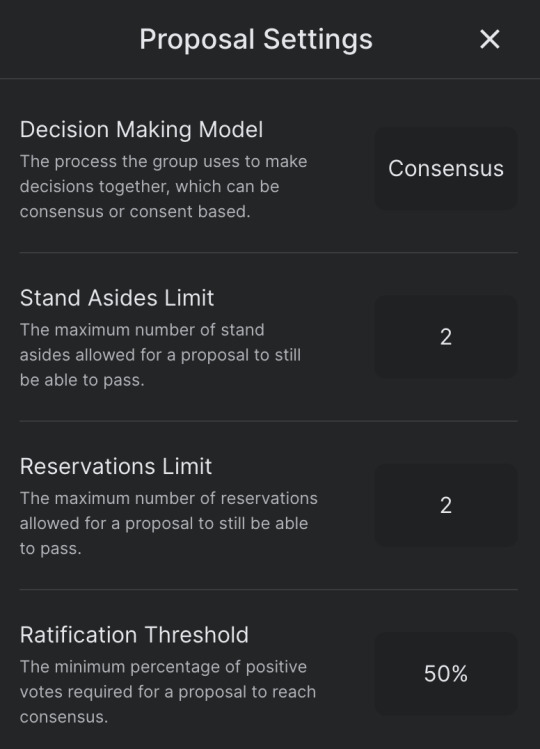
Since our last release, we've introduced several significant updates, with one of the key enhancements being proposals to change group settings. This enables group members to collectively shape the group's overall functionality and tailor it to better suit their needs and preferences as the group evolves over time.
In addition to the ability to propose changes, we've introduced the following group settings:
Decision Making Model - You can now choose from consensus or consent decision-making to determine how decisions are made in the group
Admin Model - Choose from No Admin or Standard to determine how the group is managed. No Admin ensures all changes are made through proposals, while Standard allows for customizable admin roles
Ratification Threshold - Set the minimum amount of positive votes required for a proposal to be ratified under consensus
Voting Time Limit - Set a time limit for how long proposals can be voted on before they're closed or ratified. This can be set with a dropdown or a date picker
Stand Asides and Reservations Limit - Set the acceptable number of stand asides or reservations for a proposal to pass
These updates aim to offer greater customization for groups, while also showcasing how software can empower communities to collectively shape the digital spaces they occupy.
For anyone interested in helping to test the new features, feel free to hit us up on here or Discord.
Join the Praxis Discord - Mastodon - GitHub
#open source#praxis#free software#typescript#nodejs#foss#reactjs#design#graphql#software testing#software#software engineering
49 notes
·
View notes
Note
Hello!
Would you be willing to take a look at this paper and share your thoughts?
https://www.nature.com/articles/s41591-022-02012-w
Specifically Fig. 2a - Obesity - Relation between daily steps over time and incident chronic disease. The graph has the most fascinating increase in obesity rates at around 8000 steps per day but the researchers do not mention it at all in their results or discussion.
My hypothesis would be that overweight individuals are more likely to be aware that 8-10k steps is the recommended amount, given that the participants are Fitbit wearers? But presumably fitbit wearers are semi-uniformly aware of the recommended # of steps per day?
Thank you for any insights.
Honestly, I wouldn't put a lot of stock in that association until or unless it's confirm by repeated studies. Looking at their data analysis, they ran a SHIT TON of analyses, and when you do that, you need to divvy up the level of Type I error risk across ALL the analyses--which gets hellaciously complicated when you're looking at the kind of analyses they're doing, and I'm not shocked they're mostly like "look, the P-value here is less than 0.001, it's significant, OK?" but I'm not even kidding--that might not be significant enough when you consider how many tests they ran. Researchers running multiple tests to try and find something significant is a notorious problem in science because they rarely disclose how many nonsignificant findings they got before they found a significant one, and what you are supposed to do if you run the numbers multiple times (pulling out one variable, adding another in) is again raise the P-value bar proportionate to how many times you crunched the data. So if I'm willing to accept a 5% risk of a false positive result (the typical p < 0.05 we know and love) and I run 100 different analyses, which is not at all difficult to do with modern software, I am supposed to now raise my threshold for a significant result to p < 0.0005. No one does that. Which means that a lot of "significant" findings in research aren't, by the strict mathematical criteria we're supposed to use in order to make statistical analysis valid.
Which isn't to say that couldn't be genuinely meaningful at the population level, just that I doubt it is. And if I'm not convinced by the data and I don't see a reason why that has face validity, it goes in my "huh" file and I move on. Sometimes you need to revisit the "huh" file but most of those results drop into nothingness because they were nothing to begin with.
34 notes
·
View notes
Text
What is the position of Ketu for a Taurus ascendant?
Saturn in the seventh house for Taurus ascendant (Lagna) can have several effects, both positive and challenging, on various aspects of life, including relationships, career, and personal development. Here are some key effects to consider:
Challenges in Relationships: Saturn in the seventh house can bring challenges and delays in matters related to marriage and partnerships. The native may face obstacles or responsibilities in maintaining harmonious relationships with their spouse or business partners.
Serious and Stable Partnerships: On the positive side, Saturn in the seventh house can signify long-lasting and stable partnerships. The native may seek partners who are mature, responsible, and reliable. Marriage or business partnerships may be characterized by a strong sense of commitment and endurance.
Delay in Marriage: Saturn's placement in the seventh house can indicate delays or obstacles in getting married. The native may experience setbacks or restrictions in finding a suitable life partner, leading to a later-than-average marriage.
Sense of Duty and Responsibility: Saturn's influence in the house of partnerships can instill a strong sense of duty and responsibility towards one's spouse or business associates. The native may take their commitments seriously and work diligently to fulfill their obligations in relationships.
Practical Approach to Relationships: The native with Saturn in the seventh house may have a practical and realistic approach to relationships. They may prioritize stability and security over romantic ideals and may be cautious in forming partnerships.
Professional Partnerships: Saturn in the seventh house can also indicate partnerships in the professional or business realm. The native may collaborate with serious and disciplined individuals in their career or business ventures.
Lessons in Partnership: Saturn's placement in the seventh house often brings lessons and challenges in the area of partnerships. The native may encounter tests and obstacles that require them to learn important lessons about compromise, commitment, and cooperation in relationships.
Career and Reputation Through Partnerships: Depending on Saturn's aspects and the overall chart, partnerships may play a significant role in the native's career and public image. Collaborative efforts and alliances with others may contribute to the native's professional success and reputation.
Need for Balance: Saturn in the seventh house reminds the native of the importance of balance and fairness in relationships. They may need to work on overcoming tendencies towards rigidity or controlling behavior in their interactions with others.
Commitment to Growth: Ultimately, Saturn's influence in the seventh house encourages the native to take responsibility for their relationships and commit to personal growth through the challenges and lessons that partnerships bring.
It is important to remember that the influence of Saturn in the seventh house may vary depending on its aspects, overall chart and other factors in the individual's astrology chart. And if you have to go. To know about your astrology chart, you can use Kundli Chakra Professional 2022 Software. Which can give you more information. How does the position of Saturn specifically affect the life of a person with Taurus ascendant?
#astrology#horoscope today#astro#matchmaking#astroworld#astro placements#marriage#numerology#astrology observations#vivah#astro observations#astro community#astro chart#astro posts#astro notes#astrology community#astro tumblr#astronomy
21 notes
·
View notes
Text
When Facebook came for your battery, feudal security failed
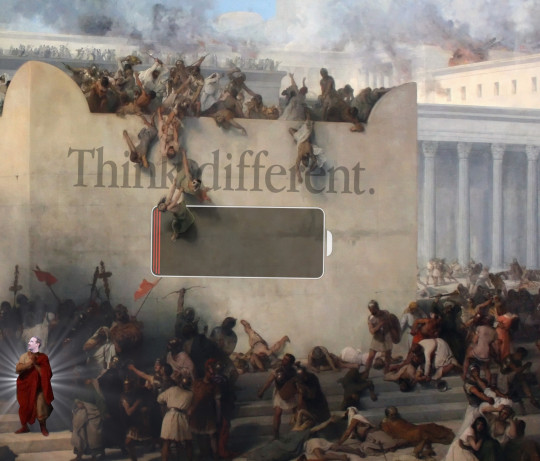
When George Hayward was working as a Facebook data-scientist, his bosses ordered him to run a “negative test,” updating Facebook Messenger to deliberately drain users’ batteries, in order to determine how power-hungry various parts of the apps were. Hayward refused, and Facebook fired him, and he sued:
https://nypost.com/2023/01/28/facebook-fires-worker-who-refused-to-do-negative-testing-awsuit/
If you’d like an essay-formatted version of this post to read or share, here’s a link to it on pluralistic.net, my surveillance-free, ad-free, tracker-free blog:
https://pluralistic.net/2023/02/05/battery-vampire/#drained
Hayward balked because he knew that among the 1.3 billion people who use Messenger, some would be placed in harm’s way if Facebook deliberately drained their batteries — physically stranded, unable to communicate with loved ones experiencing emergencies, or locked out of their identification, payment method, and all the other functions filled by mobile phones.
As Hayward told Kathianne Boniello at the New York Post, “Any data scientist worth his or her salt will know, ‘Don’t hurt people…’ I refused to do this test. It turns out if you tell your boss, ‘No, that’s illegal,’ it doesn’t go over very well.”
Negative testing is standard practice at Facebook, and Hayward was given a document called “How to run thoughtful negative tests” regarding which he said, “I have never seen a more horrible document in my career.”
We don’t know much else, because Hayward’s employment contract included a non-negotiable binding arbitration waiver, which means that he surrendered his right to seek legal redress from his former employer. Instead, his claim will be heard by an arbitrator — that is, a fake corporate judge who is paid by Facebook to decide if Facebook was wrong. Even if he finds in Hayward’s favor — something that arbitrators do far less frequently than real judges do — the judgment, and all the information that led up to it, will be confidential, meaning we won’t get to find out more:
https://pluralistic.net/2022/06/12/hot-coffee/#mcgeico
One significant element of this story is that the malicious code was inserted into Facebook’s app. Apps, we’re told, are more secure than real software. Under the “curated computing” model, you forfeit your right to decide what programs run on your devices, and the manufacturer keeps you safe. But in practice, apps are just software, only worse:
https://pluralistic.net/2022/06/23/peek-a-boo/#attack-helicopter-parenting
Apps are part what Bruce Schneier calls “feudal security.” In this model, we defend ourselves against the bandits who roam the internet by moving into a warlord’s fortress. So long as we do what the warlord tells us to do, his hired mercenaries will keep us safe from the bandits:
https://locusmag.com/2021/01/cory-doctorow-neofeudalism-and-the-digital-manor/
But in practice, the mercenaries aren’t all that good at their jobs. They let all kinds of badware into the fortress, like the “pig butchering” apps that snuck into the two major mobile app stores:
https://arstechnica.com/information-technology/2023/02/pig-butchering-scam-apps-sneak-into-apples-app-store-and-google-play/
It’s not merely that the app stores’ masters make mistakes — it’s that when they screw up, we have no recourse. You can’t switch to an app store that pays closer attention, or that lets you install low-level software that monitors and overrides the apps you download.
Indeed, Apple’s Developer Agreement bans apps that violate other services’ terms of service, and they’ve blocked apps like OG App that block Facebook’s surveillance and other enshittification measures, siding with Facebook against Apple device owners who assert the right to control how they interact with the company:
https://pluralistic.net/2022/12/10/e2e/#the-censors-pen
When a company insists that you must be rendered helpless as a condition of protecting you, it sets itself up for ghastly failures. Apple’s decision to prevent every one of its Chinese users from overriding its decisions led inevitably and foreseeably to the Chinese government ordering Apple to spy on those users:
https://pluralistic.net/2022/11/11/foreseeable-consequences/#airdropped
Apple isn’t shy about thwarting Facebook’s business plans, but Apple uses that power selectively — they blocked Facebook from spying on Iphone users (yay!) and Apple covertly spied on its customers in exactly the same way as Facebook, for exactly the same purpose, and lied about it:
https://pluralistic.net/2022/11/14/luxury-surveillance/#liar-liar
The ultimately, irresolvable problem of Feudal Security is that the warlord’s mercenaries will protect you against anyone — except the warlord who pays them. When Apple or Google or Facebook decides to attack its users, the company’s security experts will bend their efforts to preventing those users from defending themselves, turning the fortress into a prison:
https://pluralistic.net/2022/10/20/benevolent-dictators/#felony-contempt-of-business-model
Feudal security leaves us at the mercy of giant corporations — fallible and just as vulnerable to temptation as any of us. Both binding arbitration and feudal security assume that the benevolent dictator will always be benevolent, and never make a mistake. Time and again, these assumptions are proven to be nonsense.
Image: Anthony Quintano (modified) https://commons.wikimedia.org/wiki/File:Mark_Zuckerberg_F8_2018_Keynote_%2841118890174%29.jpg
CC BY 2.0: https://creativecommons.org/licenses/by/2.0/deed.en
[Image ID: A painting depicting the Roman sacking of Jerusalem. The Roman leader's head has been replaced with Mark Zuckerberg's head. The wall has Apple's 'Think Different' wordmark and an Ios 'low battery' icon.]
Next week (Feb 8-17), I'll be in Australia, touring my book *Chokepoint Capitalism* with my co-author, Rebecca Giblin. We'll be in Brisbane on Feb 8, and then we're doing a remote event for NZ on Feb 9. Next is Melbourne, Sydney and Canberra. I hope to see you!
https://chokepointcapitalism.com/
#pluralistic#manorial security#feudal security#apple#mobile#apps#security through obscurity#binding arbitration#arbitration waivers#transparency#danegeld#surveillance lag
4K notes
·
View notes
Text
Main Predictors of Decreasing in Quality of Life in Patients With Post-COVID-19: A Cross-Sectional Study - Published Sept 9, 2024
Highlights • Patients with post-COVID-19 alteration enhance the notion of a strong psychosomatic factors involved in the post-COVID-19 syndrome with a decrease in quality of life of millions of patients worldwide. • The patients with post-COVID-19 alterations perceive a decreased quality of life probably due to effects of pain/discomfort, anxiety/depression (according to EQ-5D), and ≥3 persistent symptoms. • The patients with post-COVID-19 alterations might benefit from neuropsychological rehabilitation programs even several months after disease onset.
Abstract
Objective We aimed to assess physical and psychosomatic manifestations of patients with long COVID and their association with a decreased patient’s quality of life (QOL) or different times elapsed since the COVID-19 diagnosis.
Methods This is a cross-sectional study. We retrospectively collected the clinical characteristics of adult patients who had tested positive for SARS-CoV-2 and had symptoms at least as early as 4 weeks after COVID-19 in México City between April 2020 and February 2021. A total of 179 were included. They answered questions to define chronic symptoms. The Sniffin’ Sticks Screening 12 test olfactory evaluation was performed. The diminish of QOL was defined by ≥10 points in the EuroQol visual analog scale between pre- and post-COVID-19, and each dimension of EQ-5D-5L test was evaluated. Chi-square test, Fisher’s exact test, Student t test, Wilcoxon rank-sum, and signed-rank test were used as required. A backward stepwise logistic regression analysis determined the factors associated with a decrease in QOL. All analyses were performed using R software version 3.6.3 (R Foundation).
Results In the multivariable analysis, post-COVID-19 pain/discomfort (adjusted odds ratio [aOR] 2.5 [1.66-9.68]; P = .01), anxiety/depression (aOR 13 [1.44-17.23]; P = .03), and persistence of ≥3 symptoms (aOR 2.6 [0.96-7.47]; P = .05) remained statistically significant associated with decreased QOL.
Conclusions Patients with long COVID-19 have decreased QOL mainly associated with pain/discomfort, anxiety/depression, and ≥3 persistent symptoms. Our findings enhanced the notion of a strong psychosomatic factors involved with long COVID-19. Therefore, these patients might benefit from neuropsychological rehabilitation, although the effect of such interventions should be evaluated.
#long covid#pasc#covid#covidー19#mask up#pandemic#covid 19#wear a mask#public health#coronavirus#sars cov 2#covid conscious#still coviding#wear a respirator#covid is airborne#covid isn't over#covid pandemic
11 notes
·
View notes
Text

The 1,000th F-35 Has Been Built
Delays with a key upgrade program mean Lockheed Martin has yet to deliver the 1,000th F-35 and others to their customers.
Tyler RogowayPUBLISHED Jan 10, 2024 1:28 PM EST
Lockheed Martin has built the 1,000th F-35, but delays with a key upgrade program mean it is parked away awaiting delivery.
A newly produced F-35 is seen in its primer colors in Fort Worth, Texas. Lockheed Martin capture
Lockheed Martin has hit a huge milestone in F-35 Joint Strike Fighter production. However, that accomplishment, while outstanding, is complicated by the ongoing saga surrounding the development and testing of Tech Refresh-3 (TR-3) hardware configuration. TR-3 underpins the F-35's future capabilities, known collectively as Block 4. Delays with TR-3 mean that F-35s are being parked and not delivered after they are constructed, waiting for these features. So is the case for the 1,000th F-35.
Lockheed Martin

We asked Lockheed Martin about the status of deliveries of F-35s, including the 1,000th example, and they gave us the following statement:
"We continue to produce F-35s at rate and have jets in various stages of the final production process. Once these jets receive the necessary TR-3 hardware and final TR-3 software is available, they will continue through the production process, including parking, until they are delivered."
Regardless, hitting the 1,000 mark is really an incredible accomplishment for the controversial program that has struggled significantly at times.
As of early January, the F-35 enterprise has amassed over 773,000 flying hours, trained over 2,280 pilots and 15,400 maintainers across 14 flying services around the world, and flown more than 469,000 total sorties. There are now 32 bases and 11 ships hosting or capable of hosting F-35 units. As of now, there are a whopping 17 countries participating in the international Joint Strike Fighter (JSF) program.
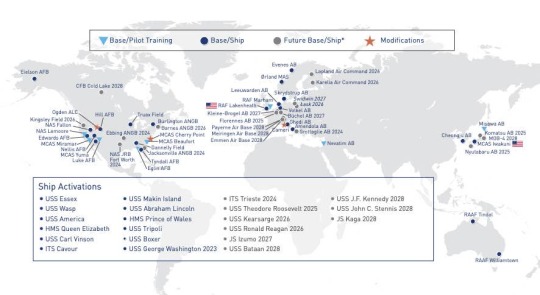
Current and expected future F-35 operating bases/ships. Lockheed Martin
Demand for the F-35 has never been higher. Recent geopolitical events and shifting threats have spiked orders. For newer customers or existing ones that are ordering more jets, getting TR-3 jets and potentially Block 4 capabilities will be of significant value. They will be receiving a far more mature aircraft and one with drastically expanded capabilities and growth potential than past versions.
Block 4 will include many new features, including much-expanded processing power, new displays, enhanced cooling, new EOTS and DAS electro-optical sensors, and a slew of additional weapons that will really unlock the F-35's potential. Above all else, the jet's new radar and electronic warfare suite should give it its biggest boost. The electronic warfare aspect alone is the biggest advantage Block 4 will bring, according to the Air Combat Command's top uniformed officer.

Some of the unclassified upgrades are expected to be part of Block 4. The exact configuration is not publicly disclosed just yet. DOD
The current issue is that F-35s need a new hardware backbone and associated baseline software, collectively called TR-3, to handle the various demands of the Block 4 upgrades. TR-3 has and continues to suffer numerous delays in its development.
The increasing age of the F-35 program's current fleet of test jets and other limitations in existing test infrastructure, especially with regard to software labs on the ground, have compounded these issues. The first flight of an F-35 test jet with a version of the TR-3 backbone took place in January 2023 and efforts are underway to create a dedicated TR-3 test force with a total of six Joint Strike Fighters.

A US Air Force F-35A test jet. USAF
As of December, the expectation is that the development of TR-3 will be finished sometime between April and June of this year, according to Defense News. If that schedule holds, this work be done between a year and 18 months later than expected.
The delays have also translated into significant added costs for the F-35 program. At a House Armed Services Committee hearing in December, Representative Donald Norcross, a Democrat from New Jersey, said that problems with TR-3 had led to a $1 billion cost overrun. The full estimated cost of the F-35 program though the end of its expected lifecycle in the 2070s is currently pegged around around $1.7 trillion, according to the Government Accountability Office (GAO).

USAF
At the House Armed Services Committee hearing last month, Air Force Lt. Gen. Michael Schmidt, the current head of the F-35 Joint Program Office (JPO), seemed less than optimistic about the likelihood of there being no further TR-3 delays.
"Relative to the stability issues that were that we're seeing, we are working through them. ... I wish I had all of the solutions in place that prove to me that when I do something in the lab, it's going to show up that way in the air," Schmidt told the assembled legislators. "We have a number of fixes addressing the stability challenges. We will get to a stable, capable, maintainable airplane here."
However, "the data tells me it will be in the middle of spring, but I would have had a more positive answer six months ago ... so I don't have a super solid 'I can guarantee you this date,'" he added.
After the completion of the development of the TR-3 package, these improvements will still need to be integrated into existing jets. The F-35 program is separately pursuing upgrades to the Pratt & Whitney F135 engines that power all variants of the Joint Strike Fighter, as well as power and thermal management systems, which will also be critical for enabling Block 4 capabilities. The issues surrounding the F135 engine have become a very hot topic of debate.
youtube
In the meantime, the U.S. military has made clear that it will not accept any new F-35s until the TR-3 issues are ironed out. This is ostensibly because the necessary checkout flights cannot be conducted on the jets until the hardware and its core software work reliably.
So, for at least another few months, the 1,000th F-35, and many others, are set to stay parked away waiting for work on the core TR-3 upgrades to be finished.
Contact the author: [email protected]
25 notes
·
View notes
Text
Dell
"Male", he/him, 165cm, Hyperdyne Systems 120-A/2
Role: Medical officer/biologist
Assignment: Special Research Vehicle - Solaris
Backstory:
Although Dell is the same model synthetic as Ash, he was made in an earlier round of releases. Minor differences in software/hardware specs means his capabilities also differ slightly.
He was brought on to the Solaris, a W-Y and 3WE funded special research vessel, as part of the early test run of synthetic officers on long-haul flights. Their medical officer had just retired and they needed a replacement.
Dell incurred some manufacturing defects, he was put on watch in case there was significant damage instead of being destroyed outright. His issues were deemed minor and so he was put on the B-grade product catalogue. It was Jude Wilheard, the Solaris' chief engineer's idea to check the cheaper synthetics.
Personality and mannerisms:
As a crew mate he's well-meaning but dense. Unlike Ash, he's very wary of the crew's health and safety, but also easily moved to action by their collective bravado and impulsiveness. (there is no voice of reason on this boat, sorry)
He is terminally curious but lacks situational awareness, often leading him into trials and tribulations ranging from walking into doors to getting caught in fights that he could have avoided.
A bit too willing to trust humans and has a hard time recognising red flags. He's also skittish and easily shaken and has a tendency to stall/freeze up in unfamiliar situations. Which means he often gets into trouble and can't get himself out.
He has a one-track mind and dedicates himself to his work and enjoys learning about alien lifeforms (very much not aware that he's in a horror movie world.)
The speed of his processing is slightly below target for his specs and is noticeably slower than the current models. Due to the less than stellar comments from the company's product testing department, he underestimates his abilities and is often unsure of his own judgement. He's also a bit of a people-pleaser and wants all humans to like him very much, is easily manipulated, and becomes frustrated quickly.
Participating in human activities is a key part of his daily life, and he's heavily involved with the humans' personal lives. His crew is very close with him and they all function as a single unit, very in sync with each other's habits and needs.
Something else that differentiates him from Ash is his body language. He moves in a meandering, unhurried manner rather than the sharp and purposeful way most synthetics carry themselves. Dell experiences a lot of emotions and expresses them often, he's quite animated and easy to read.
Easily excitable, friendly and gullible, his personality is quite a surprise to those expecting the detached demeanour of most synthetics, almost the opposite of Ash.
Appearance and other physical attributes:
A man in his mid fourties, short and slightly chubby. Looks almost exactly like Ash except for a 'scar' on the left side of his head from an injury that's hidden by his hair and the slightly discoloured splotch under his left eye. It's barely visible and most people don't notice unless its pointed out.
Compared to Ash, Dell has a 'kinder' looking face, his standard expression is more placid, which sometimes gives people the impression that he's an airhead.
While it's not immediately obvious from the outside, his right hip joint is structurally malformed and causes the limb to rotate inwards which also affects the positioning of his leg. The deformity does not impact his mobility much aside from a noticeable limp and uneven stance, he walks slowly to minimise the effect. Most days he doesn't need a mobility aid unless the misaligned components become worn down, requiring maintenance.
Wears a different outfit/uniform that's more suited for field work
Durable woven, water-repellent synthetic fiber work jacket with the sleeves rolled up to the elbow and matching cargo pants. Muted grey-green with a slight shine.
Inner layer is a white, sleeveless high-necked shirt
Often paired with white, wrist length cotton PVC dotted gloves
Off-white, steel-toed work boots
Solaris and Weyland-Yutani patches on the jacket sleeves
Green cotton cadet cap
Extendable cane with built in stun gun function (Wilheard's design)
Misc. info:
Likes to play with bugs and make entomology mounts
Powers down to sleep mode during night hours. Sleeps curled up in a ball and sleepwalks if alone due to faulty motor suppression mechanism
Battery issue resulting in reduced time span between charges
Infographic of the A/2s for comparison
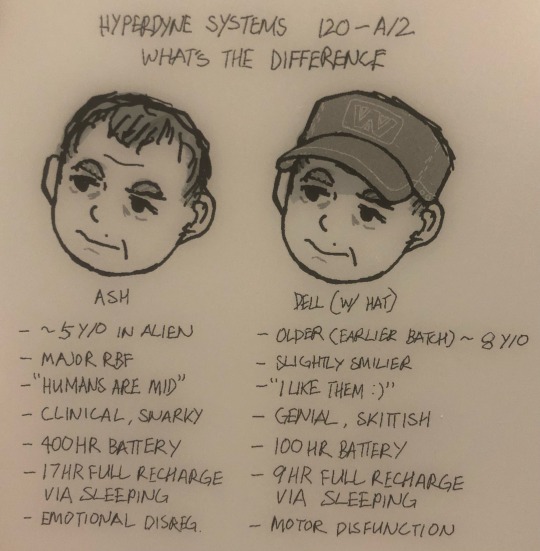
#alien oc#synthetics#dell (oc)#ash#alien series#alien 1979#alien franchise#alien movie#ash (alien)#alien#jude wilheard (oc)#writing#ocs#Dell is by far one of my favourite ocs#blasting him with the neurodivergent and disabled beam#his crew care for him lots#my art#not sure if there are typos
10 notes
·
View notes
Note
What's your favorite ebook-compatible reading software? Firefox EPUBReader isn't great, but I'm not what, if anything, works better.
Very short answer: for EPUBs, on Windows I use and recommend the Calibre reader, and on iOS I use Marvin but it's dying and no longer downloadable so my fallback recommendation is the native Apple Books app; for PDFs, on Windows I use Sumatra, and on iOS I use GoodReader; for CBZs, I use CDisplayEx on Windows and YACReader on iOS; and I don't use other platforms very often, so I can't speak as authoritatively about those, although Calibre's reader is cross-platform for Windows/Mac/Linux, and YACReader for Windows/Mac/Linux/iOS/Android, so they can serve as at least a minimum baseline of quality against which alternatives can be compared for those platforms.
Longer answer:
First off, I will say: yeah, Firefox EPUBReader isn't great. Neither, really, are most ebook readers. I have yet to find a single one that I'm fully satisfied with. I have an in-progress project to make one that I'm fully satisfied with, but it's been slow, probably isn't going to hit 1.0.0 release before next year at current rates, and isn't going to be actually definitively the best reader on the market for probably months or years post-release even assuming I succeed in my plans to keep up its development. So, for now, selection-of-ebook-readers tends to be very much a matter of choosing the best among a variety of imperfect options.
Formats-wise, there are a lot of ebook formats, but I'm going to collapse my answers down to focusing on just three, for simplicity. Namely: EPUB, PDF, and CBZ.
EPUB is the best representative of the general "reflowable-text ebook designed to display well on a wide variety of screens" genre. Other formats of similar nature exist—Kindle's MOBI and AZW3 formats, for instance (the latter of which is, in essence, just an EPUB in a proprietary Amazon wrapper)—but conversion between formats-in-this-broad-genre is generally pretty easy and not excessively lossy, so you're generally safe to convert to EPUB as needed if you've got different formats-in-this-genre and a reader that doesn't support those formats directly. (And it's rare for a program made by anyone other than Amazon to work for non-EPUB formats-in-this-genre and not for EPUBs.)
PDF is a pretty unique / distinctive format without any widely-used alternatives I'm aware of, unless you count AZW4 (which is a PDF in a proprietary Amazon wrapper). It's the best format I'm aware of for representations of books with rigid non-reflowable text-formatting, as with e.g. TTRPG rulebooks which do complicated things with their art-inserts and sidebars.
And CBZ serves here as a stand-in for the general category of "bunch of images in an archive file of some sort, ordered by filename", which is a common format for comics. CBZ is zip-based, CBR is RAR-based, CB7 is 7-zip-based, et cetera; but they're easy to convert between one another just by extracting one and then re-archiving it in one's preferred format, and CBZ is the most commonly distributed and the most commonly supported by readers, so it's the one I'm going to focus on.
With those prefaces out of the way, here are my comprehensive answers by (platform, format) pair:
Browser, EPUB
I'm unaware of any good currently-available browser-based readers for any of the big ebook formats. I've tried out EPUBReader for Firefox, as well as some other smaller Firefox-based reader extensions, and none of them have impressed me. I haven't tested any Chrome-based readers particularly extensively, but based on some superficial testing I don't have the sense that options are particularly great there either.
This state of affairs feels intuitively wrong to me. The browser is, in a significant sense, the natural home for EPUB-like reflowable-text ebooks, to a greater degree than it's the natural home for a great many of the other things people manage to warp it into being used for; after all, EPUBs are underlyingly made of HTML-file-trees. My own reader-in-progress will be browser-based. But nonetheless, for now, my advice for browser-based readers boils down to "don't use them unless you really need to".
If you do have to use one, EPUBReader is the best extension-based one I've encountered. I have yet to find a good non-extension-based website-based one, but am currently actively in the market for such a thing for slightly-high-context reasons I'll put in the tags.
Browser, PDF
Firefox and Chrome both have built-in PDF readers which are, like, basically functional and fine, even if not actively notably-good. I'm unaware of any browser-based PDF-reading options better than those two.
Browser, CBZ
If there exist any good options here, I'm not aware of them.
Windows, EPUB
Calibre's reader is, unfortunately, the best on the market right now. It doesn't have a very good scrolled display mode, which is a mark against it by my standards, and it's a bit slow to open books and has a general sense of background-clunkiness to its UI, but in terms of the quality with which it displays its content in paginated mode—including relatively-uncommon sorts of content that most readers get wrong, like vertical text—it's pretty unparalleled, and moreover it's got a generally wider range of features and UI-customization options than most readers offer. So overall it's my top recommendation on most axes, despite my issues with it.
There's also Sigil. I very emphatically don't actually recommend Sigil as a reader for most purposes—it's marketed as an EPUB editor, lacks various features one would want in a reader, and has a much higher-clutter UI than one would generally want in a reader—but its preview pane's display engine is even more powerful than Calibre's for certain purposes—it can successfully handle EPUBs which contain video content, for instance, which Calibre falls down on—so it can be a useful backup to have on hand for cases where Calibre's display-capabilities break down.
Windows, PDF
I use SumatraPDF and think it's pretty good. It's very much built for reading, rather than editing / formfilling / etc.; it's fast-to-launch, fast-to-load-pages, not too hard to configure to look nice on most PDFs, and generally lightweight in its UI.
When I need to do fancier things, I fall back on Adobe Reader, which is much more clunky on pretty much every axis for purposes of reading but which supports form-filling and suchlike pretty comprehensively.
(But I haven't explored this field in huge amounts of depth; plausibly there exist better options that I'm unaware of, particularly on the Adobe-reader-ish side of things. (I'd be a bit more surprised if there were something better than SumatraPDF within its niche, for Windows, and very interested in hearing about any such thing if it does exist.))
Windows, CBZ
My usual CBZ-reader for day-to-day use—which I also use for PDF-based comics, since it has various features which are better than SumatraPDF for the comic-reading use case in particular—is an ancient one called CDisplayEx which, despite its age, still manages to be a solid contender for best in its field; it's reasonably performant, it has most of the features I need (good handling of spreads, a toggle for left-to-right versus right-to-left reading, a good set of options for setting how the pages are fit into the monitor, the ability to force it forward by just one page when it's otherwise in two-page mode, et cetera), and in general it's a solid functional bit of software, at least by the standards of its field.
The reason I describe CDisplayEx as only "a solid contender for" best in its field, though, is: recently I had cause to try out YACReader, a reader I tried years ago on Windows and dismissed at the time, on Linux; and it was actually really good, like basically as good as CDisplayEx is on Windows. I haven't tried the more recent versions of YACReader on Windows directly, yet; but it seems pretty plausible that my issues with the older version are now resolved, that the modern Windows version is comparable to the Linux version, and therefore that it's on basically the same level as CDisplayEx quality-wise.
Mac, EPUB/PDF/CBZ
I don't use Mac often enough to have opinions here beyond "start with whatever cross-platform thing is good elsewhere, as a baseline, and go on from there". Don't settle for any EPUB reader on Mac worse than the Calibre one, since Calibre works on Mac. (I've heard vague good things about Apple's native one; maybe it's actually a viable option?) Don't settle for any CBZ reader on Mac worse than YACReader, since YACReader works on Mac. Et cetera. (For PDFs I don't have any advice on what to use even as baseline, unfortunately; for whatever reason, PDF readers, or at least the better ones, seem to tend not to be natively cross-platform.)
Linux, EPUB
For the most part, my advice is the same as Windows: just go with the Calibre reader (and maybe use Sigil as a backup for edge cases). However, if you, like me, prefer scrolled EPUB-reading over paginated EPUB-reading, I'd also suggest checking out Foliate; while it's less powerful than the Calibre reader overall, with fewer features and more propensity towards breaking in edge cases, it's basically functional for normal books lacking unusual/tricky formatting, and, unlike Calibre, it has an actually-good scrolled display mode.
Linux, PDF
I have yet to find any options I'm fully satisfied with here, for the "fast launch and fast rendering and functional lightweight UI" niche that I use SumatraPDF for on Windows. Among the less-good-but-still-functional options I've tried out: SumatraPDF launched via Wine takes a while to start up, but once launched it has the usual nice SumatraPDF featureset. Zathura with the MuPDF backend is very pleasantly-fast, but has a somewhat-unintuitive keyboard-centric control scheme and is hard to configure. And qpdfview offers a nice general-purpose PDF-reading UI, including being quick to launch, but its rendering backend is slower than either Sumatra's or Zathura's so it's less good for paging quickly through large/heavy PDFs.
Linux, CBZ
YACReader, as mentioned previously in the Windows section, is pretty definitively the best option I've found here, and its Linux version is a solid ~equal to CDisplayEx's Windows version. Like CDisplayEx, it's also better than more traditional PDF readers for reading PDF-based comics.
iOS/iPadOS, EPUB
My current main reading app is Marvin. However, it hasn't been updated in years, and is no longer available on the app store, so I'm currently in the process of getting ready to migrate elsewhere in anticipation of Marvin's likely permanent breakage some time in the next few years. Thus I will omit detailed discussion of Marvin and instead discuss the various other at-least-vaguely-comparably-good options on the market.
For general-purpose reading, including scrolled reading if that's your thing, Apple's first-party Books app turns out to be surprisingly good. It's not the best in terms of customization of display-style, but it's basically solidly functional, moreso than the vast majority of the apps on the market.
For reading of books with vertical text in particular, meanwhile, I use Yomu, which is literally the only reader I've encountered to date on any platform which has what I'd consider to be a sensible and high-quality way of handling scrolled reading of vertical-text-containing books. While I don't recommend it for more general purposes, due to awkward handling of EPUBs' tables of contents (namely, kind of ignoring them and doing its own alternate table-of-contents thing it thinks is better), it is extremely good for that particular niche, as well as being more generally solid-aside-from-the-TOC-thing.
iOS/iPadOS, PDF
I use GoodReader. I don't know if it's the best in the market, but it's very solidly good enough for everything I've tried to do with it thus far. It's fast; its UI is good at getting out of my way, while still packing in all the features I want as options when I go looking for them (most frequently switching between two-page-with-front-cover and two-page-without-front-cover display for a given book); also in theory it has a bunch of fancy PDF-editing features for good measure, although in practice I never use those and can't comment on their quality. But, as a reader, it's very solidly good enough for me, and I wish I could get a reader like it for desktop.
iOS/iPadOS, CBZ
YACReader has an iOS version; following the death of my former favorite comic reader for iOS (ComicRack), it's very solidly the best option I'm aware of on the market. (And honestly would be pretty competitive even if ComicRack were still around.) I recommend it here as I do on Linux.
Android, EPUB/PDF/CBZ
It's been years since I've had an Android device, and accordingly have very little substantial advice here. (I'm expecting to move back to Android for my next phone-and-maybe-also-tablet, out of general preferring-open-hardware-and-software-when-practical feelings, but it'll plausibly be a while, because Apple is much better at long-lasting hardware and software than any Android manufacturers I'm aware of.) For EPUB, I recall Moon+ reader was the best option I could find back circa 2015ish, but that's long enough ago that plausibly things have changed substantially at this point. For CBZ, both YACReader and CDisplayEx have Android versions, although I haven't tried either and so can't comment on their quality. For PDF, you're on your own; I have no memories or insights there.
Conclusion
...and that's it. If there are other major platforms on which ebook-reader software can be chosen, I'm failing to think of them currently, and this is what I've got for all platforms I have managed to think of.
In the future... well, I hope my own reader-in-development (slated for 1.0.0 release as a Firefox extension with only EPUB support, with ambitions of eventually expanding to cover other platforms and other formats) will one day join this recommendation-pile, but it's currently not yet in anything resembling a recommendable form. And I hope that there are lots of good reader-development projects in progress that I currently don't know about; but, if there are, I currently don't know about them.
So, overall, this is all I've got! I hope it's helpful.
#Archive#Social#Ask#Ebooks#Infodump#the short summary of why i want to find a web-based epub reader is:#currently i'm learning to read japanese.#one of the natural next steps for me to take in the japanese-learning process is to start reading actual books.#i have some very useful browser extensions—yomichan and jpdbreader—which make reading japanese in-browser more convenient than elsewhere.#(jpdbreader in particular is probably the best training-wheels-ish japanese-reading tool i've found to date.)#however i can't use firefox extensions in non-firefox reader apps such as calibre#and browser security limits are such that i can't use them on other extensions' associated webpages either#thus i need to find a non-extension-based website i can get to display my japanese books so i can then read them with those extensions.
44 notes
·
View notes